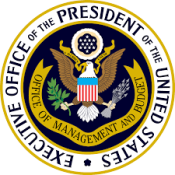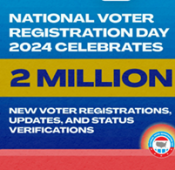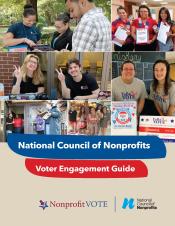A New Era in Government Grantmaking Has Begun!

Last week, a long-sought overhaul of the federal grantmaking rules went into effect, potentially converting federal grantmaking practices into potentially nonprofit-friendly experiences. Charitable nonprofits should now face lower barriers in accessing government grants and be able to secure higher reimbursement rates. The changes address longstanding problems in recovering actual costs, advance equity by removing bureaucratic barriers, and make other significant reforms that will reduce burdens and costs of seeking, performing, and reporting on grants using federal funds. Learn more.
Worth Quoting
- “The new rules embrace clarity over jargon, reject a 'measure everything' mindset, and recognize that people in communities served by programs (i.e., the clients) should be heard before programs are designed.”
— A New Era in Government Grantmaking Starts Today!, Nonprofit Champion Special Edition, National Council of Nonprofits, Oct. 1, 2024.
The Coming Tax Debate
The expiration of key provisions of the 2017 tax law at the end of 2025 sets the stage for one of the most consequential tax debates in a generation. The networks of the National Council of Nonprofits are committed to identifying and promoting fundamental tax policy proposals that will enhance the abilities of organizations to advance their missions in communities while working to ensure that adverse policies, including benign proposals with identifiable, adverse consequences, are not adopted.
Better Employment Tax Policies for Nonprofits
The ongoing nonprofit workforce shortage crisis is a clear indication that labor market economics are not working for the benefit of people served by charitable organizations throughout the country. Data show that charitable nonprofits often cannot afford to pay wages and benefits that are commensurate with similar jobs in the for-profit and government sectors. The most direct impact frequently manifests in longer waiting lines and reduced services for individuals. All sectors suffer when nonprofit child care providers are unable to pay enough to attract and retain staff to care for the children of employees of for-profit, governmental, and nonprofit employers. Nonprofit workforce shortages, therefore, are not mere inconveniences, but challenges for all residents of the United States. Congress can alleviate some of these challenges by removing existing tax policy impediments and extending to nonprofits many of the tax incentives enjoyed by businesses.
|
NOTE: The House Ways and Means Committee Republicans have set a deadline of October 15 for submissions of policy papers and comments to RepublicanTaxTeams@mail.house.gov. The National Council of Nonprofits recommends sending comments to the Republican portal and to all members of the House Ways and Means Committee. |
Read the series of tax policy papers
Worth Quoting
- “[T]he sector most dedicated to improving lives and communities – the charitable nonprofit sector – is excluded from utilizing the incentives. The result is that it actually costs more for nonprofit employers to hire and retain staff – leading to their inability to compete with for-profit employers on an equal basis. The current exclusionary policy must be corrected.”
— Tax Policies Affecting Nonprofit Employment, National Council of Nonprofits policy paper, Oct. 7, 2024.
Federal FastView
- Securing Better Nonprofit Workforce Data: In a letter to President Biden, nearly 600 charitable organizations and researchers from all 50 states are asking the President to take executive action to ensure nonprofits receive the same employment and wage data regularly made available to for-profit businesses and governments. Currently, the Bureau of Labor Statistics (BLS) conducts quarterly jobs surveys that provide significant workforce data used by businesses for planning and governments for policymaking. These data are not broken out for the charitable sector; normally nonprofit jobs data are that published only every five to seven years. The letter to the President makes clear that charitable nonprofits, Congress, and the public need more up-to-date nonprofit employment and wage data to make informed decisions.
- Promoting Arts Education: The U.S. Department of Education issued a letter of guidance to state education officials explaining how they can spend federal education dollars for arts education in developing a well-rounded education through the Elementary and Secondary Education Act. The letter states: “Arts education – including dance, media arts, music, theatre, and visual arts – is key to equitable access to a well-rounded education and central to our shared commitment to ensure that every student receives high-quality instruction that prepares them to be active, engaged, and lifelong learners.”
- Tax Exempt IRS Forms Under Review: The IRS announced last month that it is undertaking its regular paperwork reduction review of 134 forms related to tax-exempt organizations. All of the Form 990s and accompanying schedules are on the list, as is the controversial IRS Form 1023-EZ and other applications for tax-exempt status. The public comment period runs through November 12, 2024.
- Expanding Access to Affordable Child Care: Before leaving for the October recess, Senators Bennet (D-CO) and Blackburn (R-TN) introduced the Child Care for American Families Act to address challenges with affordable child care. The bill would increase the employer-provided child care credit for eligible rural areas, small businesses, and child care expenses. The Senators' news release pointed out that in 2018, approximately 51 percent of the U.S. population lived in a childcare desert, disproportionately impacting low-income and rural communities, as well as communities of color.
Worth Quoting
- “You can expand eligibility for tens of thousands of families, as the state has done, but that means nothing to a family if they can’t find a spot for their child in a program because there are not enough workers.”
— Dede Hill, Director of Policy for the Schuyler Center for Analysis and Advocacy, quoted in in New York Child Care Providers Are Bleeding Workers as Federal Money Dries Up, Julia Rock, New York Focus, Oct. 1, 2024.
Worth Studying
- We analyzed 5 years’ worth of childcare prices. Here’s what we found., Georgia Poyatzis and Gretchen Livingston, U.S. Department of Labor, Sept. 30, 2024.
Election Tip
Let Everyone Know the Election is in 28 Days
Rina Risper, Executive Director of The New Citizens Press Community Action Network and Annie Hamaty, Public Policy and Government Relations Manager at Michigan Nonprofit Association, share how nonprofits can collaborate with niche media services to connect to more communities on nonpartisan voting information.
Not All Government Grant and Contracting Policy News is Good
The positive news about government grants reform has energized nonprofit advocacy across the country, but the latest news is not good.
- Prompt Payment and Fair Reimbursement: Continuing a troubling trend in blocking reforms at the last step in the legislative process, California Governor Newsom recently vetoed two measures important to the California Nonprofit Equity Initiative. The first bill (S.B. 1246) would have extended the Prompt Payment Act to all state contracts performed by nonprofits and required government agencies to pay certain undisputed portions of a disputed invoice within 45 day. The other (S.B. 336) would have streamlined coverage of nonprofits’ indirect costs, providing consistency with the federal government’s approach. Learn more from this analysis.
- Salary Caps: Legislators in Suffolk County, New York are considering a measure (Intro. Res. No. 1687-2024) to prohibit contracts with any “contract agency,” namely nonprofits, that provides salaries higher than the Governor, currently set at $250,000 per year. Hospitals and federally qualified health centers would be exempt, and others could seek waivers. The bill would also expand disclosure requirements to include the salary of every employee, officer, director, or member of the “contract agency” rather than only the top five employees, plus all gifts and donations and donor’s names and addresses. A hearing last week was recessed, which keeps the bill alive and open for amendments until the next meeting at the end of November.
Get Engaged
Government Grants Reforms in the States
It’s great news that the federal grantmaking process has gotten more nonprofit friendly (see lead article), but nonprofit advocates aren’t sitting back and hoping the reform momentum naturally carries to their states. Nonprofit advocacy efforts are well underway across the country and readers can get engaged immediately. Here are some upcoming opportunities:
- Mississippi: Oct. 17, Demystifying Federal Grant Writing, Mississippi Alliance of Nonprofits and Philanthropy
- Oregon: Oct. 24, Modernizing Grant Funding Task Force Recommendations, Nonprofit Association of Oregon
- Vermont: Oct. 9, Advancing State Grant & Contract Reform in 2025, Common Good Vermont
- Washington State: Oct. 24, Nonprofit Government Contracting Coalition, Nonprofit Association of Washington
State and Local Fiscal Recovery Funds Success Stories:
Habitat for Humanity of Ohio
The State and Local Fiscal Recovery Funds (SLFRF) program provides unprecedented opportunities for charitable nonprofits to secure vital funding to overcome challenges caused or exacerbated by the pandemic. Yet, charitable organizations have not received their fair share of these funds – less than 5% of total SLFRF spending – and the deadline for governments to obligate any remaining funds is rapidly approaching. With this and other articles, the National Council of Nonprofits is highlighting successful advocacy stories that, we hope, will inspire nonprofits to identify and pursue these funds in their local communities. In this article, we lift up Habitat for Humanity of Ohio and the $25 million investment secured from the state of Ohio as an advocacy and development success story.
Don’t Forget
Spread the Word, Time is Running Out!
The State and Local Fiscal Recovery Funds program is closing at the end of this year. Any state or local government that doesn’t obligate (commit in a written agreement) remaining funds by Dec. 31, 2024, must send the money back to the federal government. As of today, 85 days remain for charitable nonprofits to 1) contact their local budget/finance offices to confirm how much funding is left, 2) develop a proposal for the remaining funds, and 3) send it to local officials before it is too late.
Reminder: Advocacy is key to securing any remaining funds in your town, city, or county. More resources on how to advocate and secure funding are covered in the recent webinar, Accessing Remaining Covid Funds Before It's Too Late, and Accessing State and Local Fiscal Recovery Funds page.
Outlawing Deepfakes in the Elections Arena
Voters should take extra care this year that the information they are consuming regarding candidates is accurate and not generated by artificial intelligence (AI) meant to deceive the public. At least 26 states have passed or are considering bills to regulate and restrict the use of AI in election-related activities, according to an analysis by Axios. Nineteen states have passed laws to ban “deepfakes,” artificial media made with AI to show people or events that are not real, over the past five years. In 2019, Texas was the first state to ban deepfake videos “created with the intent to deceive, that appears to depict a real person performing an action that did not occur in reality.” Laws in California, Michigan, and Minnesota restrict AI generated deepfakes within certain periods before an election. Florida, Indiana, New Mexico, Utah, Washington, and Wisconsin have enacted laws that require disclosures of AI-generated content in campaign communications and political ads. Finally, a bill in Delaware is awaiting the Governor’s signature.
Worth Studying
- 2024 North West Nonprofit Capacity Report, analyzing the capacity of charitable nonprofits in Alaska, Idaho, Montana, Oregon, and Washington to carry out their missions, Oct. 2024.
- 2024 Current Conditions of Minnesota’s Nonprofit Sector, Minnesota Council of Nonprofits, Sept. 2024.
- Community Perspectives Survey: Insights from the Field: Health of entities serving low- and moderate-income communities, Nishesh Chalise, Violeta Gutkowski, and Steven Howland, Fed Communities, Aug. 28, 2024.
- Civic Engagement in the 2022 U.S. Transgender Survey, Advocates for Trans Equality Education Fund, Aug. 2024.
Numbers in the News
$199 Trillion
The wealth held by families in the United States in 2022, four times higher than in 1989 ($52 trillion in 2022 dollars). In 2022, families in the top 10 percent of the distribution held 60 percent of all wealth, up from 56 percent in 1989, and families in the top 1 percent of the distribution held 27 percent, up from 23 percent in 1989.
Source: Trends in the Distribution of Family Wealth, 1989 to 2022, Congressional Budget Office, October 2024.

2 million
The number of new registrations, updates, and status verifications conducted on September 17, National Voter Registration Day.
Source: Letter to our 2024 Partners, National Voter Registration Day, Oct. 2, 2024; NVRD Instagram post.
October is
- Breast Cancer Awareness Month
- LGBTQ+ History Month
- National Arts and Humanities Month
- World Blindness Awareness Month
Nonprofit Events
- Oct. 9-11, Annual Conference – in person, Montana Nonprofit Association
- Oct. 10, UNA Annual Conference, Utah Nonprofits Association
- Oct. 10-11, Annual Conference, Minnesota Council of Nonprofits
- Oct. 15, Legislative Watch: Exploring Open Primaries and Nonprofit Advocacy, Idaho Nonprofit Center
- Oct. 17, Lobbying vs. Advocacy: Taking Civic Engagement Under the Dome, Mississippi Alliance of Nonprofits and Philanthropy
- Oct. 21, Annual Convention & Expo, Providers’ Council
- Oct. 22, Narrative Essentials: Effective Storytelling and Issue Messaging for Stronger Advocacy, CalNonprofits
- Oct. 22, Iowa Nonprofit Summit, Iowa Nonprofit Alliance
- Oct. 22-23, Annual Conference, North Carolina Center for Nonprofits
- Oct. 23, Advocacy & Lobbying for Nonprofits: Basics, Montana Nonprofit Association
- Oct. 23, Vermont Nonprofit Summit, Common Good Vermont
Nonprofit VOTE Webinar:
Get Informed, Get Out, Get VOTING!
Oct. 8 | 2:00 pm Eastern
Nonprofit VOTE and many other say it's on all of us to make sure the voters (and soon-to-be voters!) in our communities can make a plan to hit the polls. This webinar will cover voter-facing resources for learning about what's on the ballot, absentee voting guidance, and best practices for how to get out the vote.
Engage and learn about your candidates. Then go vote.
Now’s the time to be talking to candidates, learning about their priorities, and focusing their attention on the needs of your communities. Whether you are hosting or attending events, charitable nonprofits play an important role in nonpartisan candidate engagement so you, your community, and even your candidates are more educated in the voting booth.

the full guide.
Sharing policy ideas with candidates is paramount to informing them about needs and solutions in their communities and to encourage them to have a robust agenda if/when they are elected. Some ways nonprofits can engage with candidates and remain nonpartisan are by inviting them to events, hosting candidate forums, or conducting candidate questions. Below are some tips and hints from the Nonprofit Nonpartisan Voter Engagement Guide on how nonprofits can remain nonpartisan in each of those circumstances.
And if it’s too late to put on your own candidate event, we suggest attending a local event and asking questions. We have recommendations for that too.
Stay in the Loop
Want to be the first to know policy developments and operational trends affecting nonprofits? Sign-up to receive our free newsletters, Nonprofit Champion and Nonprofit Essentials, and browse the archive of past editions.
Sign-up